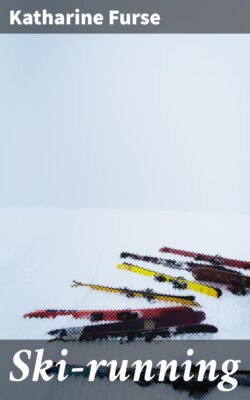Ski-running

Реклама. ООО «ЛитРес», ИНН: 7719571260.
Оглавление
Katharine Furse. Ski-running
Ski-running
Table of Contents
PREFACE
PREFACE. HISTORY OF SKI-ING. COST OF A SKI-ING HOLIDAY IN WINTER. SKI-ING CENTRES. CLOTHING. EQUIPMENT. CARE OF EQUIPMENT. THE ELEMENTS OF SKI-ING. ETIQUETTE. SNOW AND LIGHT. FALLS. TESTS. GUIDES AND SKI INSTRUCTORS. MAPS AND FINDING THE WAY. AVALANCHES. ACCIDENTS. THE ATTRACTIONS OF SKI-ING. SUMMER SKI-ING. APPENDIX: REGULATIONS OF THE BRITISH SKI TESTS. INDEX. ACHIEVEMENT! MAP OF SWITZERLAND. THE UPHILL TRACK. POWDER SNOW. SPRING. SKI-RUNNING
HISTORY OF SKI-ING
COST OF A SKI-ING HOLIDAY IN WINTER
SKI-ING CENTRES
FOOTNOTES:
CLOTHING
EQUIPMENT
CARE OF EQUIPMENT
THE ELEMENTS OF SKI-ING
ETIQUETTE
SNOW AND LIGHT
FALLS
TESTS
Part (a) is a climb of 1,500 feet in not more than 1–½ hours and a run down 1,500 feet in a time set by the judges. The time may not be less than seven, or more than twenty minutes. It should not be more than 12 minutes under good conditions
Part (b) consists of four consecutive lifted stem-turns on a slope of 15° to 20°, and Part (c) four consecutive Telemark turns on a slope of the same gradient. Parts (b) and (c) are often used as a qualifying test before Part (a) is run, in order to limit the entries for Part (a), which may otherwise be a very difficult test to run when a large field enters for it
GUIDES AND SKI INSTRUCTORS
MAPS AND FINDING THE WAY
ROUGH TABLE OF GRADIENTS
AVALANCHES
ACCIDENTS
THE ATTRACTIONS OF SKI-ING
SUMMER SKI-ING
REGULATIONS OF THE BRITISH SKI TESTS
AS APPROVED BY. THE FEDERAL COUNCIL OF BRITISH SKI CLUBS. 1923. GENERAL REGULATIONS
CROSS COUNTRY SKI-ING TESTS. GENERAL INSTRUCTIONS TO JUDGES
THE THIRD CLASS TEST (CROSS COUNTRY)
Part (a).—The ascent of 1,500 feet in not more than 1 hour 30 minutes, and the descent of the same distance within a time which shall be decided by the Judges. This time shall not be less than 7 minutes, nor more than 20 minutes, and shall not exceed 12 minutes unless sanctioned by a Second Class Judge or member of the Emergency Committee who is present and judging. Part (b).—Four continuous Lifted Stemming turns on a slope of hard snow or hard snow covered by a shallow layer of soft snow. The angle of the slope to be between 15–20 degrees. Part (c).—Four continuous Telemarks in soft snow on a slope of similar gradient. INSTRUCTIONS TO JUDGES
QUALIFYING TEST FOR THE SECOND CLASS (CROSS COUNTRY)
Part (a).—Four continuous Lifted Stemming turns on a slope of hard snow at an angle of 25–30 degrees. Part (b).—Four continuous Telemark turns on a slope of soft snow at an angle of 25–30 degrees. Part (c).—Christiania swings to a standstill (right and left) from a direct descent at a fair speed. INSTRUCTIONS TO JUDGES
THE SECOND CLASS TEST (CROSS COUNTRY)
Part (a).—A descent of not less than 2,500 feet, mainly on soft snow. The course selected should provide opportunities for straight running on reasonably steep slopes. Part (b).—A descent of not less than 1,000 feet on hard snow, such as unbreakable crust or snow which has been thoroughly beaten down. Part (c).—A descent of at least 500 feet of woodrunning, dense enough to prevent straight running, but not too dense to prevent continuous turns
QUALIFYING TEST FOR THE FIRST CLASS (CROSS COUNTRY)
Part (a).—Four continuous lifted Stemming turns on a slope of hard snow at an angle of not less than 30 degrees. Part (b).—Four continuous Telemark turns on a slope of soft snow at an angle of not less than 30. Part (c).—Four consecutive jump-turns to connect downhill tacks on a slope of breakable crust at an angle of about 30 degrees. Part (d).—Christiania swings to a standstill (right and left) from a direct descent at a very high speed. Part (e).—Four continuous Christiania (see General Instructions) on a slope of about 20 degrees. INSTRUCTIONS TO JUDGES
FIRST CLASS TEST (CROSS COUNTRY SKI-ING)
Part (a).—A descent of not less than 2,500 feet, which should, if possible, be continuous without any intervening stretches of level or uphill. The course selected must provide ample opportunity for fast, straight running, and must also include a fair proportion of steep and difficult ground. Part (b).—A descent of not less than 1,000 feet on really difficult snow, such as hard, wind-swept, unbreakable crust, on which Lifted Stemming turns are practicable but Telemarks impossible, varied by breakable crust in which only Jump turns are practicable. Part (c).—A descent of not less than 500 feet of difficult woodrunning in which continuous turns are just possible for a first-class runner.
SKI-JUMPING TESTS. GENERAL REGULATIONS
THIRD CLASS TEST (JUMPING)
SECOND CLASS TEST (JUMPING)
INDEX
Отрывок из книги
Katharine Furse
Published by Good Press, 2020
.....
FALLS
TESTS
.....